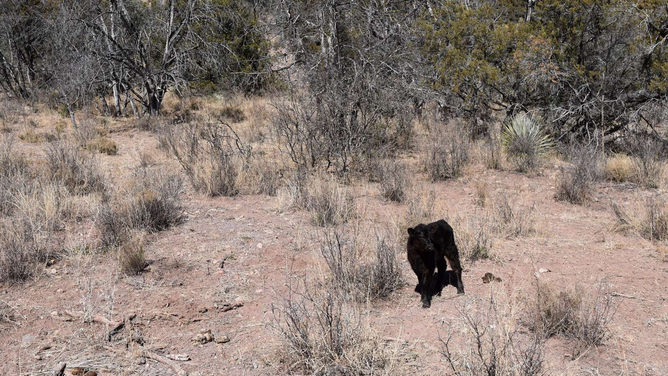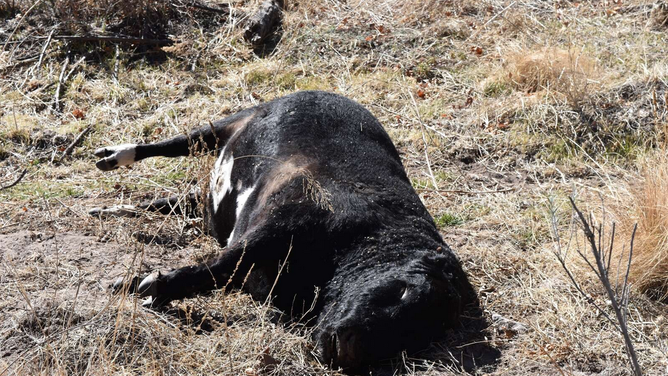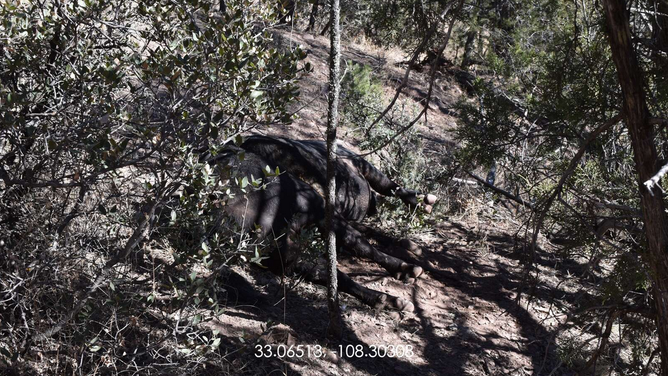Aerial shooting of cattle closes Gila National Forest in New Mexico
The New Mexico Cattle Growers Association claims that the aerial shootings are inhumane and not legal, while the USFS says, 'The most efficient and humane way to deal with this issue is with the responsible lethal removal of the feral cattle.'

Orphaned stray cattle in the Gila Wilderness.
(NMCGA / FOX Weather)
GILA NATIONAL FOREST, N.M. – The U.S. Forest Service closed part of the Gila National Forest Monday to ready the area for three days of killing feral cattle from a helicopter in an effort to preserve the wildland environment.
"The feral cattle in the Gila Wilderness have been aggressive towards wilderness visitors, graze year-round, and trample stream banks and springs, causing erosion and sedimentation," Camille Howes, Gila National Forest Supervisor, said in a statement. "This action will help restore the wilderness character of the Gila Wilderness enjoyed by visitors from across the country."
The Forest Service estimates that around 150 head of cattle roam the land freely. The rough terrain makes taking an accurate count difficult. A spokesperson for the USFS reported that they received several accounts over the years of a bull charging visitors and overgrazed areas, according to a news release by the New Mexico Cattle Growers Association.

A cow shot and left to decay during the USFS's 2021 culling program.
(NMCGA / FOX Weather)
What is aerial shooting?
Thursday through Sunday, the USFS plans to send up a helicopter with a crew, including a shooter. They will attempt to hunt down and exterminate all 150 cows and allow them to decompose naturally. The U.S. Department of Agriculture has approved the disposal method.
"The most efficient and humane way to deal with this issue is with the responsible lethal removal of the feral cattle," wrote the USFS in the statement.
‘KOWBUCHA’ COULD REDUCE METHANE PRODUCED FROM COW BURPS, STUDY SHOWS
In that statement, Howes also said, "This has been a difficult decision, but the lethal removal of feral cattle from the Gila Wilderness is necessary to protect public safety, threatened and endangered species habitats, water quality, and the natural character of the Gila Wilderness."
The NMCGA tried to block the plan. They call the action inhumane and dangerous.
"We believe as our association, the New Mexico Cattle Growers Association, that those cattle can be gathered in a humane and ethical way and not just shot and left on the forest floor," said Loren Patterson, NMCGA President.
This is the second year the USFS culled cattle through aerial shooting. The NMGCA posted pictures on social media of the 2022 slaughter of 65 head of cattle. The president discussed some of the issues brought up after going over records.
HOW TO WATCH FOX WEATHER ON TV
"There were many of those cattle that didn't have clean kills," said Patterson. "Those cattle ended up in the Gila River and died in the river. So obviously, water quality is one of the issues."
Another big issue is predator or livestock interactions, he added.
"They're talking about shooting up to 200 head this year," Patterson continued. "That's a very significant number of cattle all rotting at one time."
Previous removal techniques were non-lethal
In 2021, the USFS collected about 50 cattle from the Gila Wilderness and sold them at a livestock auction. The Forest Service says they have removed over 640 unauthorized and unbranded cattle from Gila.
"The removal operation is part of a decades-long effort to protect natural resources and stem the spread of unauthorized cattle that have been in the removal area since the 1970s," the Forest Service wrote in a 2021 news release. "Unmanaged cattle cause long-term damage to water quality, riparian ecosystem conditions, and habitat for threatened and endangered species."

A cow killed in the 2021 culling.
(NMCGA / FOX Weather)
Patterson is in favor of collection and removal, calling it more humane. The NMCGA also argues that the animals are domesticated strays, not feral cattle.
"There is no such thing statutorily as feral cattle. They are strays," said Patterson. "In New Mexico, there are no statutory (feral cattle) through our New Mexico Livestock Board, which is the regulatory agency for domestic cattle in New Mexico."
The Livestock Board has control of unidentified cattle.

(USDA / FOX Weather)
"Stray cattle in the state of New Mexico belong to the New Mexico Livestock Board," Patterson continued. "If they sell those cattle at auction, the money is held in escrow for two years. And anybody, if they have proof that those cattle belonged to them, they can claim the money."
How did the cattle get into the Gila National Forest?
The cattle grazed the Gila State Forest legally about 40 years ago, explained Patterson. The USFS is in control of 84 grazing permits that ranchers can apply for. One rancher held a permit and had about 800 animals in the wildland, but he said the grazing didn’t financially make sense, so he turned in his permit.

File: Cowboys round up cattle near the Gila National Forest.
(CORBIS / Getty Images)
"And then the Forest Service went in there and bulldozes the infrastructure like the corals, the watering, etc. and never reissued that grazing permit," said Patterson.
Without fences, the remaining cattle ran free.
Cattle escaped from nearby ranches
Cattle have been known to break free of nearby ranches and make their home in the Gila Wildlife, said Patterson, especially after recent monsoon rains and mudslides took a toll on ranch fencing. Patterson says that some of the Gila herd could be legally owned by ranchers, so those ranchers were given 10 days to clear out their cattle.
"They're not going in there to determine if the cattle that were shot belong to anybody," said Patterson. "Considering how rough the terrain is, that's ridiculous. How is somebody who might be missing cattle going to go in there and get all of their cattle out of 160,000 acres? I mean, that you can't even cover that in a helicopter in a day."
MONSOON FLOODING YOU NEED TO SEE TO BELIEVE: WEEKEND RAINS AND RESCUES
The association is considering filing a temporary restraining order to stop Thursday’s shooting.
"Part of our long-term solution to keep this from happening again is to re-authorize some of those grazing permits so that there's always people out there stewarding the land and keeping unauthorized, unmanaged cattle from getting where they don't need to be," said Patterson of the NMCGA’s proposal to the government.